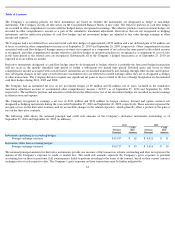Apple 2010 Annual Report Download - page 55
Download and view the complete annual report
Please find page 55 of the 2010 Apple annual report below. You can navigate through the pages in the report by either clicking on the pages listed below, or by using the keyword search tool below to find specific information within the annual report.
Table of Contents
Revenue Recognition for Arrangements with Multiple Deliverables
For multi-element arrangements that include tangible products that contain software that is essential to the tangible product’
s functionality and
undelivered software elements that relate to the tangible product’
s essential software, the Company allocates revenue to all deliverables based on
their relative selling prices. In such circumstances, the Company uses a hierarchy to determine the selling price to be used for allocating revenue
to deliverables: (i) vendor-specific objective evidence of fair value (“VSOE”), (ii) third-party evidence of selling price (“TPE”),
and (iii) best
estimate of the selling price (“ESP”).
VSOE generally exists only when the Company sells the deliverable separately and is the price actually
charged by the Company for that deliverable. ESPs reflect the Company’
s best estimates of what the selling prices of elements would be if they
were sold regularly on a stand-alone basis.
As described in more detail below, for all past and current sales of iPhone, iPad, Apple TV and for sales of iPod touch beginning in June 2010,
the Company has indicated it may from time-to-
time provide future unspecified software upgrades and features free of charge to customers. The
Company has identified two deliverables in arrangements involving the sale of these devices. The first deliverable is the hardware and software
essential to the functionality of the hardware device delivered at the time of sale. The second deliverable is the embedded right included with the
purchase of iPhone, iPad, iPod touch and Apple TV to receive on a when-and-if-
available basis, future unspecified software upgrades and
features relating to the product’
s essential software. The Company has allocated revenue between these two deliverables using the relative
selling price method. Because the Company has neither VSOE nor TPE for the two deliverables, the allocation of revenue has been based on the
Company’
s ESPs. Amounts allocated to the delivered hardware and the related essential software are recognized at the time of sale provided the
other conditions for revenue recognition have been met. Amounts allocated to the embedded unspecified software upgrade rights are deferred
and recognized on a straight-line basis over the 24-
month estimated life of each of these devices. All product cost of sales, including estimated
warranty costs, are recognized at the time of sale. Costs for engineering and sales and marketing are expensed as incurred.
The Company’
s process for determining its ESP for deliverables without VSOE or TPE considers multiple factors that may vary depending upon
the unique facts and circumstances related to each deliverable. The Company believes its customers, particularly consumers, would be reluctant
to buy unspecified software upgrade rights related to iPhone, iPad, iPod touch and Apple TV. This view is primarily based on the fact that
unspecified upgrade rights do not obligate the Company to provide upgrades at a particular time or at all, and do not specify to customers which
upgrades or features will be delivered. Therefore, the Company has concluded that if it were to sell upgrade rights on a standalone basis,
including those rights associated with iPhone, iPad, iPod touch and Apple TV, the selling price would be relatively low. Key factors considered
by the Company in developing the ESPs for these upgrade rights include prices charged by the Company for similar offerings, the Company’
s
historical pricing practices, the nature of the upgrade rights (e.g., unspecified and when-and-if-
available), and the relative ESP of the upgrade
rights as compared to the total selling price of the product. The Company may also consider, when appropriate, the impact of other products and
services, including advertising services, on selling price assumptions when developing and reviewing its ESPs for software upgrade rights and
related deliverables. The Company may also consider additional factors as appropriate, including the pricing of competitive alternatives if they
exist, and product-specific business objectives.
Beginning in the third quarter of 2010 in conjunction with the announcement of iOS 4, the Company’
s ESPs for the embedded software upgrade
rights included with iPhone, iPad and iPod touch reflect the positive financial impact expected by the Company as a result of its introduction of a
mobile advertising platform for these devices and the expectation of customers regarding software that includes or supports an advertising
component. iOS 4 supports iAd, the Company’
s new mobile advertising platform, which enables applications on iPhone, iPad and iPod touch to
embed media-rich advertisements.
For all periods presented, the Company’
s ESP for the embedded software upgrade right included with each Apple TV sold is $10. The
Company’s ESP for the software upgrade right included with each iPhone sold through the
52
























